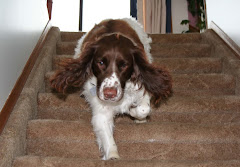Can you recommend any GOOD serger project books, or serging books that you think are invaluable?Even though I own several sewing and quilting books, I only have one serger book.
Maybe you could do a blog post on your serger, what you make with it, and how much you love it. *hint hint* I just didn’t find many blog posts from ‘Sergers’ (people) when I looked.
My serger is a White Superlock 2000, that I purchased new in March 1997 for $700 CAD.
It uses up to four spools of thread, has a differential feed, a scrap catcher tray and a built in thread cutter.
Sergers are even more finicky to thread then sewing machines. Not only must they be threaded correctly, they have to be threaded in this exact order:- upper looper (blue)
- lower looper (purple)
- right needle (yellow)
- left needle (green)
One of the things I love about this serger is that the entire bottom opens up, for easy threading and cleaning.
I usually tie on the new thread colour for threading the upper and lower loopers. Then I manually thread the duel needles.
For this post, I manually threaded the loopers as well as the needles using the same four colours of thread that the guide shows. This serger is easy to thread.
Here I removed the presser foot. Needle nose pliers or long thin tweezers are excellent tools for threading sergers.
Before serging anything, always start a thread chain to ensure the machine is threaded correctly and in the correct order.
Then serge a scrap of fabric to check the tensions.
Whenever, I'm setting the tension on my serger I use contrasting thread colours to quickly identify which loopers or needles require adjusting. The purple side (lower looper) is the bottom and blue (upper looper) is the top. The first strips I serged are on the right and the last one is purple on the left. On the back side the left needle tension was too loose and not even. I tightened it in six very tiny increments.
The tension disks on this serger are very similar to the upper tension dial on mechanical sewing machines. It is important to thread the machine with the presser foot up and make sure the thread is set in between the tension disks.
I'm sewing a denim dog bed for my grand-dog Penny.
Serging is fun and I love the professional finish.
See the little white button on the harp, just right of the presser foot...that is the built-in thread cutter, pressing it down raises the little blade behind the presser foot.
This is such a cool feature. I didn't realize what a wonderful thing it was until I used a serger without one.
Dog bed completed. I sure hope Penny likes it.
I use my serger when sewing garments, dinner napkins, tablecloths, tea towels, flannel pj bottoms, nylon bags, cotton bags, Christmas stockings, Halloween costumes, curtains, place mats, hair towels, oven mitts and baby quilts. It serges wonderful rolled hems on fine fabrics like sheer curtains. I finish the seams on garments with it. When I make baby quilts, first I sew the pieces together, then overlock them and finally top stitch the seams in place using a zig zag stitch on a sewing machine. I do this because baby quilts get washed frequently. For tea towels I serge the edges, then fold over once and hem.
My White Superlock was made in China and is available as a Husqvarna or a Singer serger. The Singer does not have a scrap catcher, but comes with three extra feet.
My only regret with my serger is that I didn't buy it sooner. Happy serging and sewing.
December 28, 2020 Update
In 2015, I gave this serger to my grown daughter in Ontario and replaced it with a Pfaff Coverstitch 3.0. In August 2020, I traded the Pfaff Coverstitch in to buy the identical machine, only this time it is branded a Husqvarna HClass 250S.
This manual is available for free download here.
I bought the same machine because it is the easy to thread, clean and a joy to serge with. Happy stitching all. 
















































































Thank you Tammy. Hopefully Santa can order my Serger next week!!!
ReplyDeleteYay doggie bed! I know a puppy who will love it :D
ReplyDeleteThanks so much. I just inherited one of these and have played a little with it and love it already. I have already broken a few needles doing things I shouldn't, not adjusting tension for bulky fabric and not checking if the thread was twisted on spools when reopening after storage. But sometimes I learn lessons the hard way! It was great to see a little overview from someone else. Now that I have to go buy new needles, does it use regular needles? I'm confused by all the needle lingo/numbers and can't seem to match up the numbers with the ones that are available in the stores. Are regular machine needles fine?
ReplyDeleteThanks again.
Stephanie
Hi Steph,
ReplyDeleteThank you very much for leaving a comment. I'm quite delighted to share my experiences.
Yes the White overlock uses regular sewing machine needles. I use Schmetz universal 70/10 (for shears and thin fabric), 80/12 for cottons and 90/14 for heavy fabric. It will not fit the 100/16 needles they are too big. The differential feed is really important when sewing heavy fabric or very thin fabric. My machine would not serge cut one layer of serged oven mitt material sandwiched to one layer of denim quilted fabric. So what I did with those oven mitts was serged the pieces without cutting the fabric in the serger and then sewed the two pieces together with a sewing machine.
Do you know what the letters P and R mean on the stitch length dial?
ReplyDeleteHello Lori, The letter R is the stitch length setting for a rolled edge. This technique is normally used on soft fabrics, such as crepe de chine, georgette, silk and other light weight materials. This technique cuts, folds and overlocks the edge to give a fine 1.5mm rolled edge. I used the rolled edge when making light weight dinner napkins and when sewing shear fabrics.
DeleteThe P setting is for Picot or shell edge. This edging is perfect for chiffon, silk or other light weight fabrics.
These are both three thread stitches. When using the R or P settings the left needle and the stitch finger are removed.
Hi Tammy
ReplyDeleteI have this White Serger, the 2000ATS as well and have never been able to figure out how to make it create the Rolled Edge. I can't find my Manual and am at a total loss on what to remove and what to use, and which threads, etc.
Any hints?? THANKS.
Rolled hems require three not four threads. Remove the stitch finger and the left needle. Set the stitch length dial to "R" Use a thin light fabric. Set the differential feed to less than 1. Try it out on a piece of scrap fabric. Hope this helps you out.
DeleteI have had this serger for over 8 years and have never been able to get it to sew any length of times. I doubt if it has 10 hours on it. As far as I am concerned it is a POS. My singer that is 25 year old 3 needle is a much better machine.
ReplyDeleteHi Kandilin, sounds like there is something really wrong with your serger, perhaps you got a lemon. Why won't your machine serge, is the thread breaking, poor stitch quality? Have you had it serviced by a professional? I bought my white overlock serger new in 1997. It has serged hours and days at a time with no problems at all. I made this anti-bullying blanket in 2013.
Deletehttp://tammyscraftemporium.blogspot.ca/2013/11/antibullying-week-november-17-23-2013.html
anyone know of a video how to replace the moving cutter blade on a White 2000 ATS
DeleteSorry, I do not know of a video for do-it-yourself. My serger came with an extra cutting blade which to date has not been installed. When that time comes, I'm taking to the Brandon Sewing Centre where I bought it and paying the technician to do it.
DeleteI recently acquired my white 2000. I have never serged before so it is a little daunting. My main issue so far, is that I cannot get it to make a chain. I have rethreaded it a couple times, but still no chain... any thoughts?
ReplyDeleteHi Allison, My first thought is that it is not threaded in the correct order and/or properly. It is super finicky about that. It could also be tension settings on all or any of the upper/lower looper, right and left needle. Perhaps one or both needles is not inserted correctly. Do you have the manual? If all else fails take it to a sewing machine dealer that sells Pfaff, Singer and Husqvarna/Viking machines.
DeleteFor those who have lost their manual, I found it online:
ReplyDeletePart 1
http://www.singerco.com/uploads/download/984_sl-2000-ats-wb-a-x.pdf
Part 2
http://www.singerco.com/uploads/download/985_sl-2000-ats-wb-b-x.pdf
Thank you for posting such helpful photos, and thank you to the person above who posted links to the manual!
ReplyDeleteIt's a longshot, but I'm having trouble with getting the stitch finger installed correctly, and so far I haven't found any help online. Is there a trick? The stitches aren't forming over it and then coming off, they are backing up and getting stuck. Thanks for all the help already, though!! ❤
Hi Rose, Sorry I no longer have this overlock, I gave it to my daughter in Ontario. From memory, inserting the stitch finger was a little tricky because it could be installed with the finger part in the slot instead of slot part. I hope this makes sense. My best advice is to remove it, follow the manual and reinsert it this putting the part you had in the slot out and the finger part in. On page 39 of the manual for a Singer 14J250 serger there is a good illustration that shows how to insert the stitch finger. this pdf file is available for free download at www.singerco.com. Hope this helps you out.
DeleteYou're an angel! Thanks so much! The pictures for this are much clearer in the Singer manual than they were in the White manual.
DeleteThanks again!
WHERE I CAN GET PARTS OF THIS MACHINE??
ReplyDeleteHello Mar, I don't know where you live. I live in Brandon, Manitoba Canada. Parts for my serger are readily available at local Brandon Sewing Centre. My best advice is find a retailer who sells the serger you have to enquire about parts. This serger was also under the Singer name 14J250 so a Singer dealer should be able to get you parts. Hope this helps.
DeleteWhere i can get parts for this machine¿
ReplyDeleteHi Tammy, I just found this today. It was posted several years ago but is sooo helpful. I have one of these machines. It was given to me by my daughter-in-law after her mother came down with alzheimer's and had to go into a nursing home. The foot pedal, scrap bin and manual are all missing. I don't know if all the feet are with it either. But it looks like an easy machine to use once I can figure it out. I did find a manual for free on line. I am pretty sure I can find the foot pedal on e-bay. I just ordered the book that you recommended above. But the pictures that you have included in your post are WONDERFUL !! I noticed that you marked the front of your machine just below the tensions with the numbers 1,2,3 & 4. I am assuming that they are on there to mark which ones to thread in that sequence is that correct? This posting has been so helpful. Thank you so much!! Mimi, Glendive, Montana
ReplyDeleteYes I numbered the tension dials in the order to thread the machine. This machine is wonderful to use and really user friendly. I hope you enjoy it.
DeleteI just got a White Superlock 2000 ATS with 50 cones of thread for $20. I always wanted a surger but was intimidated. Very newbie question...can you do straight sewing on this machine, or do i need a regular sewing machine as well. Thinking of putting it in my camper. Thanks!
ReplyDeleteHi, I just obtained a White Superlock 2000 ATS serger. I always wanted to try one, but was always intimidated by them. Being new to the serger world, I was wondering if sergers can be used as regular sewing machines, or only serve to serge edges. Thanks much!
ReplyDeleteSergers can do lots of things but they do not replace a sewing machine. Sergers do not have a reverse. 3-4 thread sergers can do fancy rolled hems and finish seams wonderfully. I do not believe you can put zippers in garments or make button holes with a serger. Hope this helps.
DeleteI know this post is old, but it led me to a manual with a decent picture of the stitch finger installation for my White Superlock 2000 ats. Thank you, and the internet is a wonderful thing.
ReplyDeleteYou are most welcome and yes the internet is amazing.
DeleteWow...I can hardly believe that Mary Douglas got this machine and 50 cones of thread for $20 !!! Good for you Mary!! Tammy, I have a question though. I was able to download the owners manual for this machine. But having some confusion. On the diagram of the machine, it calls the knob on the right side closest to the front the stitch length dial....ok, got it. But the manual calls the dial closed to the back the, "differential feed control dial". The numbers on it only go from 0.7 - 2 I was trying to find how to adjust the stitch width and in the manual, it says the stitch width should be 6. I do not see any dials that go up to that number. So what is the "differential feed control"? and where is the stitch width adjustment? Thank you for your help!
ReplyDeletethe differential feed control is adjustable for the thickness of fabric, .07 is for light sheer #2 is for heavy thick layers. on the left hand side #7 in the manual is the overedge cutting width dial. the white overlock does not have a stitch width dial. the stitch length dial is #24 in manual and located on the right side of the machine. hope this helps you out. you have a fantastic machine. mine is 25 years old and still works wonderfully.
DeleteWhere did you find the manual? Ive searched and can't find it.
DeleteAbout 2006 Husqvarna, Pfaff, Singer and White merged globally. This identical serger has been manufactured as a Singer and Husqvarna overlock. My first Serger was this White Superlock that I gave to my grown up daughter in 2015. In August 2020 I bought the same machine new only now it is a Husqvarna HClass 250S. The free manual download is located here:https://www.husqvarnaviking.com/SiteMedia/Products/Machines/Support/HCLASS_200S_manual_EN_FR_ES.pdf
DeleteHi Tammy I am looking for a presser foot for a white super lock model 2000. I live in Nova Scotia Canada Thank you
ReplyDeleteHi Theresa, This serger is available for purchase new from an authorized Singer, Husqvarna dealer. I'm confident a replacement presser foot is available. The Brandon Sewing Centre where I bought my machine would ship it to you via Canada Post.
DeleteTheresa, Ralph Hiscock in Stellarton Nova Scotia repairs sewing machines. He may be able to help you.
DeleteI purchased a used White Superlock. Perhaps, not as sophisticated as yours. It was a store model in a sewing store, closed due to the recession of 2009. It was fine for the first couple of years. I taught myself. I took off the blade. I only use it to serge edges of each piece prior to sewing seams, I sew garments for extra income. It sews correctly for the first inch or so but then, the fabric bounces, it stops stitching altogether and the R needle gets wrapped. I say wrapped because I have no other way to explain. I considered poor quality thread but I've go down every other rabbit hole, troubleshooting for a couple of hours. Would you suggest I take it in for servicing? Or, is it operator error?
ReplyDeleteHmmm before taking it in for service put the cutting blade back on. I have never removed the cutting blade as it is easy to use the serger without cutting the edge by lining up the fabric edge beside the blade instead of underneath the blade. I suspect your problem is operator error. In August 2020, I bought this identical serger again after I grew frustrated with issues on my Pfaff coverstitch 3.0. I love this model it is hassle free with excellent precise stitches. As you use yours for garment construction I don’t understand why you wouldn’t sew your garment together with your sewing machine then overcast the edges to finish your seams like store bought. If putting the blade back on doesn’t correct your issues, try cleaning the machine thoroughly, oiling it and putting in new needles. Then rethread it and test it out. Hope this helps you out.
DeleteAgreed! Be kind to yourself: brush and clean, oil and change your HAx1 needles frequently. Take all thread out and start over. Thread your machine ALWAYS in the proper order. You don't have to remove the cutter: To disengage the cutter open the swing away side cover (Pg 4 and 25) and push the "gearish" looking knob <<--- toward you (not easy to do) and then roll it downward. BTW I use my serger frequently to cut bias strips by running it without thread. I downloaded the manual Tammy shared... it is the same manual I have. Check your thread tension disk and make sure the thread is in it. Good luck and keep surging. Oh.. Nancy Ziemann has great youtube videos on sewing w a serger.
ReplyDeleteI was just gifted the White Overlock 2000 ATS serger from my daughter's mother-in-law. I am newly retired and I am enjoying sewing pajama's for my 4 grandkids. I am excited on learning how to use my new machine. This blog is amazing and the pictures are so helpful. I know I will be referring to this site for help and guidance in the near future. Thank you for this site!
ReplyDelete